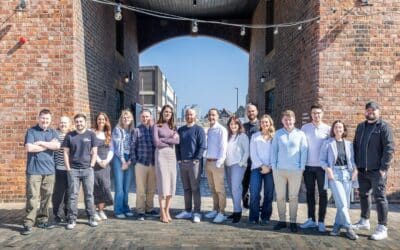PrettyLittleThing’s recent rebrand has caused a stir online as it transitions away from its pink-fuelled unicorn haze for a more serious, grown up look.
It’s a “legacy in progress”, CEO Umar Kamani recently told Steven Bartlett as he unveiled the news in a short video clip online.
Beyond the sleek aesthetics, the Manchester online fashion giant appears to be hinting at a shift away from its fast fashion roots. Yet for eagle-eyed customers and brand experts, they are still puzzled over one key question: how is PrettyLittleThing really going to shake-up its image if the rebrand neglects to address the real impact of fast fashion?
For a rebrand to “really land”, customers need to feel a transformation “beyond just a new logo, color palette or font, no matter how styylish,” said Jo Taylor, founder and director of purpose-led micro-agency BrandXYZ.
“Yes, on the surface it looks shiny, new and exciting but have its brand values and customer proposition actually changed deep down?
Taylor recently founded BrandXYZ after spearheading The Bee Network’s transformative transport branding and marketing, and has previously worked at top agencies such as McCann and Tangerine Communications. And she’s not a fan of the ‘It Girl’ rebrand positioning.
“I find it really interesting they claim that they previously stopped listening to their audience, hinting that now they are – yet they continue to use terminology like ‘It Girl’ in their rebrand positioning, which makes me shudder. At a time when the industry is supposedly evolving towards inclusivity and authenticity, this phrase definitely feels outdated and out of touch. Fashion audiences are savvier than ever, questioning not just what brands sell but what they represent.”

On PrettyLittleThing’s shift away from fast fashion, she explained: “I’m genuinely interested to see if they can make the move away from fast fashion but with Umar Kamani still maintaining they’ll have dresses on site for £4 but better quality, the real question is: how? The material might be better but at that price point are we looking at a situation where costs continue to be squeezed elsewhere in the supply chain – if so, that’s not an improvement on the issues fast fashion creates.”
As the PrettyLittleThing shopper has grown up, times and attitudes have evolved too, and there are now new, more successful players in town who can challenge on price point – and purpose.
“Sustainability is a growing expectation, and PLT’s rebrand needs to address the real impact of fashion on people and the planet, something they seem to noticeably have neglected to talk about in their rebrand comms so far,” she adds.
“Ultimately, a rebrand is only as strong as its follow-through. If PLT wants this to be more than a cosmetic change, they need to prove how they’re evolving as a brand—and customers old and new will be watching closely.”
She’s not alone. With a marketing spin on things, Amy Gleave, digital marketing manager at Cheadle-based brand agency Dawn, has been eyeing the social media posts which appear to be calling out the brand’s shift towards luxury too.
“One user on Instagram said: “I miss the pink cutesy stuff. This is also made out of polyester… so luxury is definitely not your market”, while another said “All you’ve done is copy Molly Mae’s entire brand aesthetic (and price point) all whilst still using 95% polyester ??? Boring.”

A rebrand should “always be about change that is more than skin-deep”.
“It looks like they’re trying to market themselves as a high-end luxury brand, but the quality and values just don’t match up,” she explained. “I get that they’re trying to grow with their audience, but those kinds of people care about more than just fancy branding and they want good quality, and fair working conditions for employees.
“If they’re not fixing the real issues, they’re just making the brand feel more expensive (people online have said their baskets have tripled in price) without offering anything more, which is only going to push away the people who used to shop there for it being cheap. It’ll be interesting to see how it rolls out and if they’re changing things that go deeper than what’s on the surface like suppliers etc.”
Fellow Dawn-er and head of design Oli Furze has a slightly more optimistic take: “It might well be a step in the right direction. There is a lot of work to be done but if this inspires real change in practices and values it’s a good thing,” he said.
Althought PrettyLittleThing hasn’t necessarily mentioned a change in practices yet, “it’s inferred they are at least trying to do something differently”.
He adds: “It’s probably less disingenuous than saying they are no longer a fast fashion brand overnight. You never know, it may be that nothing will change, but sometimes you have to let these things play out”.













